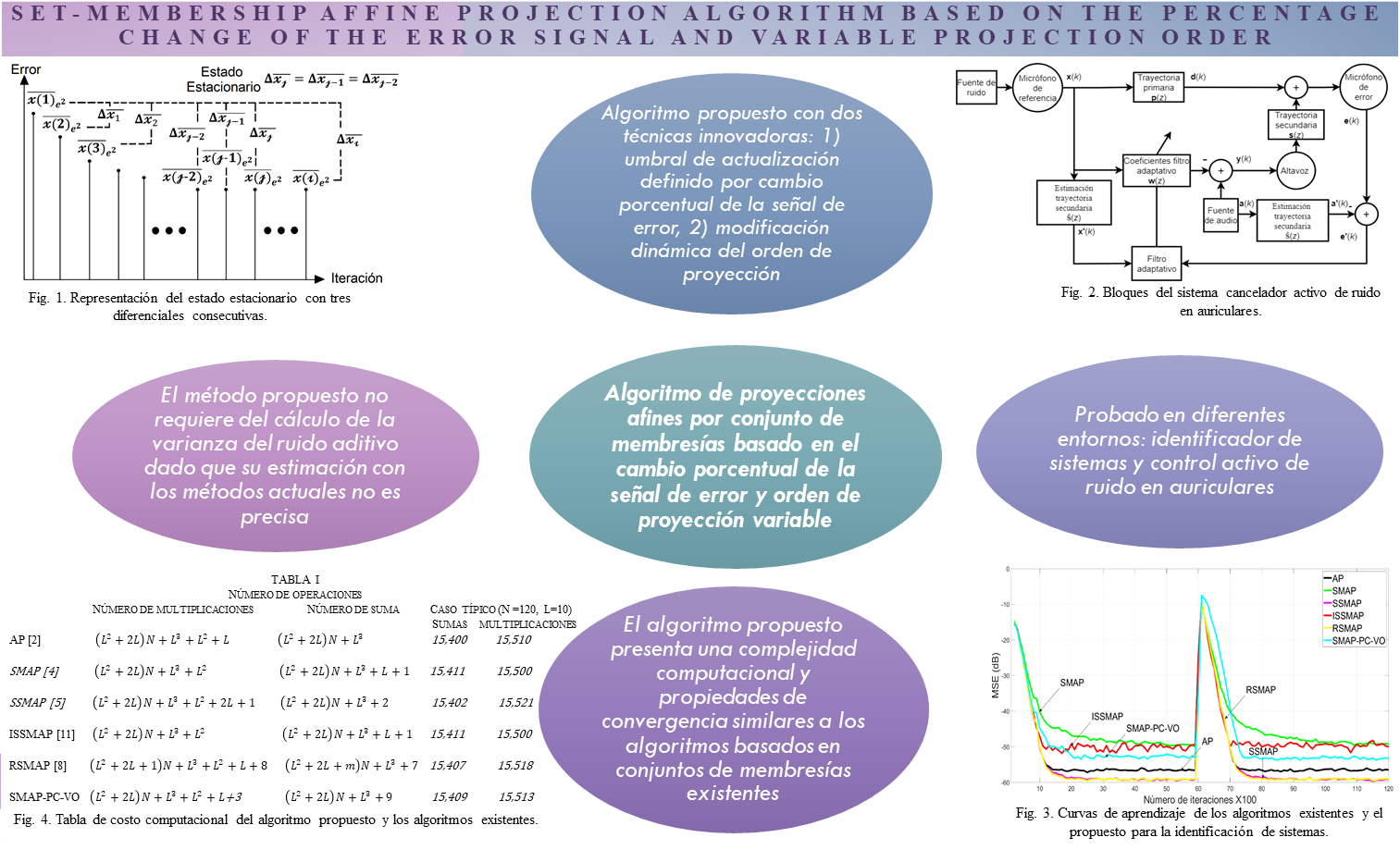Set-membership affine projection algorithm based on the percentage change of the error signal and variable projection order
Keywords:
set-membership algorithm, affine projection algorithm, data selective algorithms, variable projection orderAbstract
Nowadays, the use of adaptive filters plays an important role in multiple signal processing applications, such as active noise control, acoustic echo cancellers, system identifiers, channel equalizer, among others. Until date, many of the existing adaptive algorithms such as affine projection algorithms offer a high convergence speed. However, its computational cost is also high. Currently, several authors make extraordinary efforts to reduce its computational cost to be used in practical applications. In this paper, we propose a new set-membership affine projection algorithm based on the percentage change of the error signal and variable projection order (SMAP-PC-VO). Specifically, we propose two techniques to create this algorithm; 1) the new algorithm uses an error bound, which is obtained by calcuting the percentage change of the error signal, to avoid the computation of the variance of additive noise, since in existing approaches this parameter determines the error bound. In practical applications, the computation of the variance of additive noise is infeasible since this signal is not available; 2) we propose a new method to dynamically modify the projection order in the new algorithm. As a consequence, its computational cost is reduced. To demonstrate its performance, the proposed algorithm was successfully tested in different environments for system identification and active noise control for headphone applications. The simulation results demonstrate that the proposed algorithm presents good convergence properties. In addition, the proposed algorithm exhibits a low overall computational complexity.
Downloads
References
D. Trihinas, G. Pallis, y M. D. Dikaiakos, “Low-Cost Adaptive Monitoring Techniques for the Internet of Things”, IEEE Trans. Serv. Comput., vol. 14, núm. 2, pp. 487–501, mar. 2021, doi: 10.1109/TSC.2018.2808956.
K. Ozeki, Theory of Affine Projection Algorithms for Adaptive Filtering, vol. 22. Tokyo: Springer Japan, 2016. doi: 10.1007/978-4-431-55738-8.
J. R. Deller, “Set membership identification in digital signal processing,” IEEE ASSP Mag., vol. 6, no. 4, pp. 4–20, Oct. 1989, doi: 10.1109/53.41661
S. Werner y P. S. R. Diniz, “Set-membership affine projection algorithm”, IEEE Signal Process. Lett., vol. 8, núm. 8, pp. 231–235, ago. 2001, doi: 10.1109/97.935739.
P. S. R. Diniz, “Convergence Performance of the Simplified Set-Membership Affine Projection Algorithm”, Circuits Syst Signal Process, vol. 30, núm. 2, pp. 439–462, abr. 2011, doi: 10.1007/s00034-010-9219-z.
Md. Z. A. Bhotto y A. Antoniou, “Robust Set-Membership Affine-Projection Adaptive-Filtering Algorithm”, IEEE Trans. Signal Process., vol. 60, núm. 1, pp. 73–81, ene. 2012, doi: 10.1109/TSP.2011.2170980.
H. Zhao y Z. Zheng, “L 0 norm constraint set‐membership affine projection algorithm with coefficient vector reuse”, Electron. lett., vol. 52, núm. 7, pp. 560–562, abr. 2016, doi: 10.1049/el.2015.3386.
Z. Zheng y H. Zhao, “Robust Set-Membership Affine Projection Algorithm with Coefficient Vector Reuse”, Circuits Syst Signal Process, vol. 36, núm. 9, pp. 3843–3853, sep. 2017, doi: 10.1007/s00034-016-0471-8.
W. A. Martins, M. V. S. Lima, P. S. R. Diniz, y T. N. Ferreira, “Optimal constraint vectors for set-membership affine projection algorithms”, Signal Processing, vol. 134, pp. 285–294, may 2017, doi: 10.1016/j.sigpro.2016.11.025.
J. G. Avalos, J. Mendoza, F. A. Serrano, y G. Avalos, “Set-Membership Affine Projection-Like Algorithm with Evolving Order”, IEEE Latin Am. Trans., vol. 16, núm. 3, pp. 770–776, mar. 2018, doi: 10.1109/TLA.2018.8358654.
H. Yazdanpanah, P. S. R. Diniz, y M. V. S. Lima, “Improved simple set‐membership affine projection algorithm for sparse system modelling: Analysis and implementation”, IET signal process., vol. 14, núm. 2, pp. 81–88, abr. 2020, doi: 10.1049/iet-spr.2019.0294.
V. Belyi y W. Gan “A combined bilateral and binaural active noise control algorithm for closed-back headphones”, Applied Acoustics, p. 13, 2020.


